10 Enchanting Botanical Maze Ideas to Transform Your Garden
1. Classic Boxwood Hedge Maze
Create a timeless garden feature with boxwood hedges arranged in intricate patterns. These slow-growing evergreens maintain their shape beautifully throughout the year, providing structure and elegance. Plant them 12-18 inches apart in well-draining soil and trim regularly to maintain crisp edges and uniform height.
2. Lavender Labyrinth
Design a sensory experience with winding pathways of fragrant lavender. This Mediterranean-inspired maze not only looks stunning with its purple blooms but also fills the air with calming scent. Choose drought-resistant varieties like English or French lavender and plant in full sun locations for optimal flowering.
3. Wildflower Meadow Maze
Transform your garden with informal pathways cut through vibrant wildflowers. This pollinator-friendly option creates a magical, ever-changing maze that evolves with the seasons. Mow clear paths through native wildflower mixes, allowing taller flowers to form the “walls” while supporting local biodiversity.
4. Bamboo Forest Maze
Create an exotic retreat with tall bamboo varieties forming mysterious corridors and hidden spaces. The rustling leaves add an auditory element to the maze experience. Choose clumping bamboo varieties rather than running types, and install proper root barriers to prevent unwanted spreading.
5. Children’s Sunflower Maze
Design a temporary summer wonder with towering sunflowers creating golden walls. This kid-friendly option provides a magical experience as children navigate through corridors of these cheerful giants. Plant mammoth varieties in late spring, spacing them 12 inches apart in rows 3 feet apart for optimal density.
6. Edible Herb Spiral Maze
Combine form and function with a spiral-shaped maze filled with culinary and medicinal herbs. This space-efficient design creates microclimates for different herb varieties while offering an aromatic journey. Arrange herbs from drought-tolerant varieties at the top to moisture-loving types at the bottom of the spiral.
7. Rose Garden Labyrinth
Create a romantic journey through climbing and shrub roses in coordinated colors. The intoxicating fragrance and stunning blooms transform an ordinary garden into a sensory paradise. Incorporate arbors and trellises at key intersections to add vertical interest and create defined “rooms” within your maze.
8. Winter Interest Conifer Maze
Design a year-round attraction with diverse evergreens in varying heights, textures, and colors. This maze remains visually striking even during winter months when other plants have died back. Mix varieties like blue spruce, gold thread cypress, and columnar junipers for a tapestry of evergreen hues.
9. Butterfly and Pollinator Pathway
Create a purposeful maze using pollinator-friendly plants like coneflowers, butterfly bush, and milkweed. This ecological design supports local wildlife while providing beautiful flowering corridors. Arrange plants by height with taller varieties forming walls and shorter flowering plants lining the pathways.
10. Japanese-Inspired Zen Maze
Design a contemplative space using cloud-pruned shrubs, ornamental grasses, and carefully placed stones. This minimalist approach focuses on tranquility and mindful walking. Incorporate raked gravel pathways between sculptural plants for a meditative journey that encourages visitors to slow down and appreciate each carefully designed turn.
Creating the Perfect Hedge Maze: Choosing the Right Plants
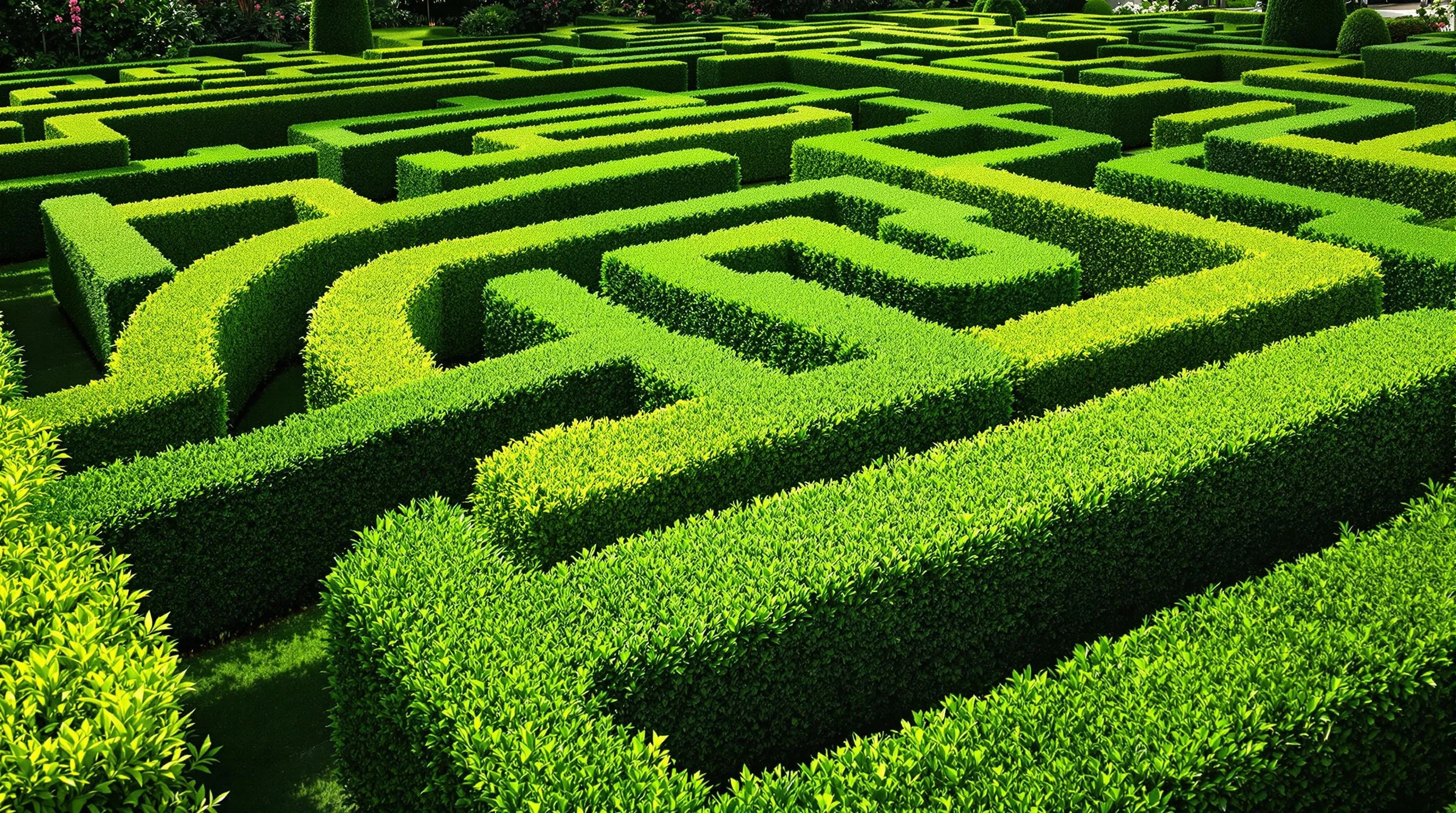
The foundation of any spectacular hedge maze lies in selecting the right plant varieties. Your choice of hedging material will determine not only the aesthetics but also the maintenance requirements and longevity of your maze.
Classic Yew and Boxwood Options
Yew (Taxus baccata) and boxwood (Buxus sempervirens) remain the gold standards for traditional hedge mazes with good reason. Yew offers exceptional longevity, with specimens known to survive for centuries while maintaining their dense, dark green foliage that can be clipped into precise forms. This evergreen creates a dramatic backdrop year-round and responds well to heavy pruning. Boxwood provides a finer texture with its small, glossy leaves and grows more slowly (6-8 inches annually), allowing for intricate designs with crisp, clean lines. Both plants maintain their structure in winter, ensuring your maze remains navigable and visually striking throughout all seasons. For formal mazes with historical appeal, these classics deliver unmatched architectural presence and proven reliability.
Fast-Growing Alternatives for Impatient Gardeners
If waiting decades for your maze to mature isn’t appealing, several faster-growing options can establish a functional maze within 3-5 years. Privet (Ligustrum) grows up to 3 feet annually and forms dense barriers quickly, though requiring more frequent trimming to maintain shape. Hornbeam (Carpinus betulus) offers rapid growth with attractive pleated foliage that holds brown leaves through winter, providing year-round structure. Laurel varieties like Portuguese laurel (Prunus lusitanica) combine quick establishment with glossy, evergreen leaves and excellent disease resistance. For temporary mazes or those on tighter timelines, consider using bamboo varieties which can create impressive height within a single growing season. While these alternatives may not match the centuries-long permanence of yew, they’ll transform your garden space into a navigable maze significantly faster while still providing the essential structure and privacy that make hedge mazes so captivating.
Lavender Labyrinths: Combining Fragrance and Form
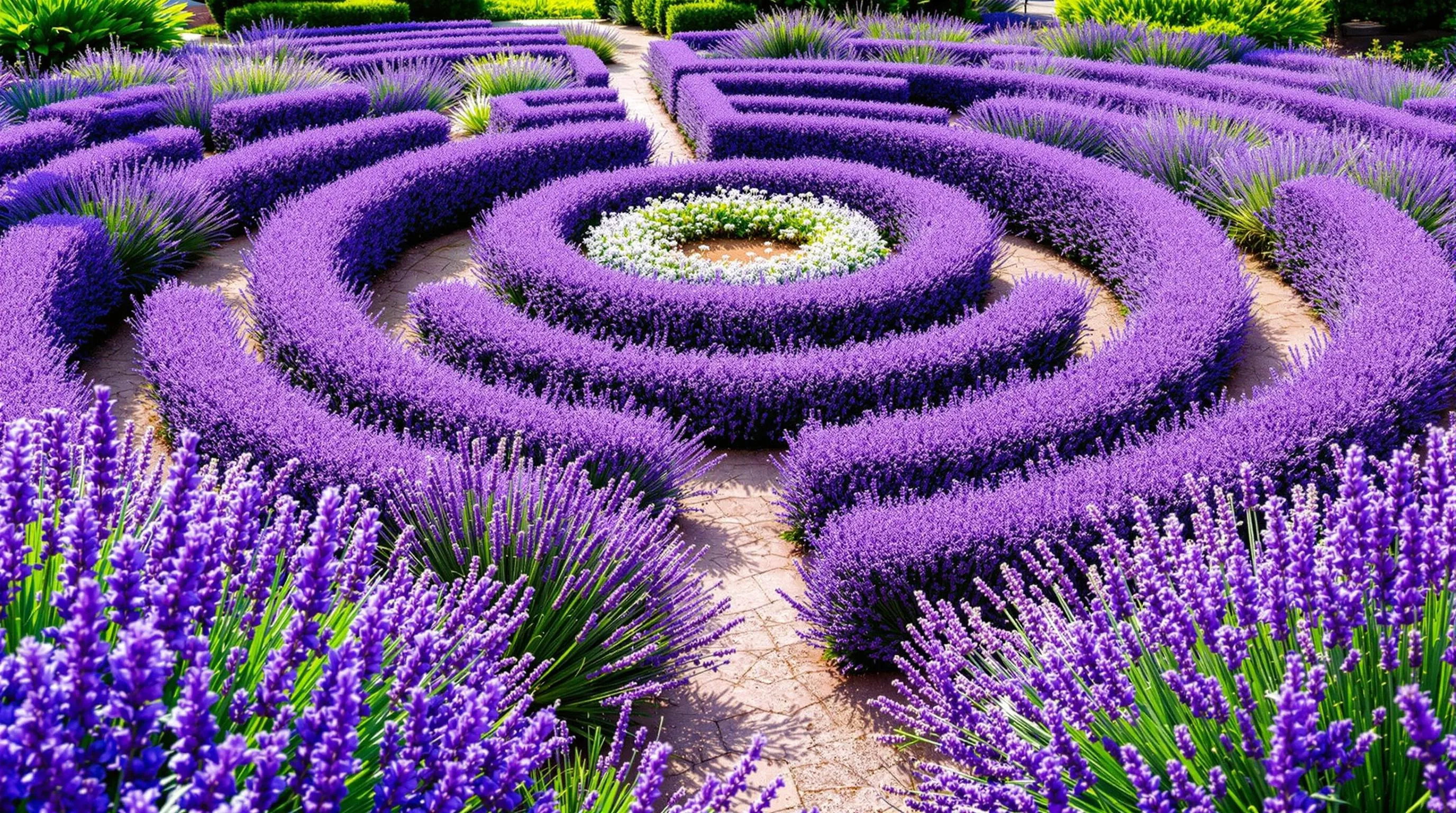
Lavender labyrinths offer a sensory journey that combines the visual elegance of a maze with the calming fragrance of lavender plants. Unlike traditional hedge mazes that focus primarily on creating puzzling pathways, lavender labyrinths engage multiple senses as you navigate through them. The aromatic purple blooms create stunning patterns when viewed from above while providing a therapeutic walking experience at ground level.
English and French lavender varieties work exceptionally well for creating defined pathways in your labyrinth design. Plant lavender in concentric circles or spiral patterns with 2-3 feet between rows to allow for growth and easy navigation. The silver-gray foliage provides year-round structure, while the summer blooms transform your maze into a purple paradise that attracts beneficial pollinators to your garden.
Maintenance Tips for Aromatic Maze Pathways
Maintain your lavender labyrinth by pruning plants annually after flowering to prevent woodiness and maintain shape. Cut back about one-third of the growth in late summer or early fall, avoiding cutting into old wood. Water newly planted lavender regularly until established, then reduce to minimal irrigation as these Mediterranean natives prefer dry conditions. Apply a light layer of compost annually but avoid heavy fertilization which produces leggy growth at the expense of flowers. Control weeds vigilantly during the establishment phase using mulch between pathways, and replace individual plants that fail to thrive to maintain the integrity of your labyrinth pattern. For colder climates, select hardy lavender varieties like ‘Hidcote’ or ‘Munstead’ to ensure your fragrant maze survives winter conditions.
Seasonal Blooming Mazes That Change Throughout the Year

Create a ever-changing botanical maze that transforms with the seasons, offering visitors a new experience every few months. These ever-changing labyrinths showcase nature’s rhythm while providing year-round interest and multiple reasons for guests to return.
Spring to Winter Transition Planning
Design your seasonal maze with careful plant selection to ensure continuous visual interest throughout the year. Start with early spring bulbs like tulips and daffodils that give way to summer perennials such as coneflowers and black-eyed Susans. Incorporate late-blooming asters and sedums for fall color, then rely on ornamental grasses, berry-producing shrubs, and evergreens for winter structure. Plant these seasonal stars in sequential blooming zones within your maze layout, ensuring at least three plant varieties per season overlap in bloom time to prevent bare spots. Consider incorporating QR codes on weatherproof signage that visitors can scan to learn what’s currently blooming and what changes to expect on their next visit. This thoughtful transition planning transforms a static garden feature into a living calendar that celebrates seasonal change.
Creating Quarterly Bloom Schedules
Developing a quarterly bloom schedule ensures your maze remains visually stunning throughout the year. For spring (March-May), incorporate bulbs like hyacinths and muscari along with flowering shrubs such as forsythia and azaleas. Summer (June-August) can showcase hydrangeas, roses, and annual cutting flowers like zinnias and cosmos. For fall (September-November), transition to ornamental grasses, chrysanthemums, and goldenrod. Winter interest (December-February) comes from holly, winterberry, witch hazel, and hellebores. Map these plants strategically throughout your maze, balancing heights and bloom times to maintain defined pathways while providing continuous color. Document your bloom progression with weekly photos to refine your schedule for future years, adjusting plant selections based on performance. Consider creating a visual timeline for visitors showing what’s currently blooming and what’s coming next, building anticipation for return visits.
Plant Selection for Continuous Color
Choose plants that offer sequential blooming periods to maintain vibrant color throughout the growing season. Early bloomers like crocus and snowdrops (zones 3-8) announce spring’s arrival, followed by mid-spring tulips and late-spring alliums. Summer brings a wealth of options including echinacea, rudbeckia, and daylilies that provide weeks of color. For late summer through fall, incorporate Japanese anemones, sedum ‘Autumn Joy’, and toad lilies. Select varieties with multiple seasons of interest—plants like Viburnum that offer spring flowers, summer berries, and fall foliage color. Layer your plantings with bulbs beneath perennials and shrubs to maximize vertical space and bloom time. Consider foliage color too—silver artemisia, burgundy heuchera, and golden hakone grass add visual interest even when nothing’s flowering. Track bloom times in your exact climate zone to identify and fill any gaps in your color sequence.
Incorporating Structural Elements for Winter Interest
Transform your winter maze with structural elements that shine when flowers fade. Install archways adorned with evergreen clematis or wintergreen honeysuckle to maintain vertical interest. Incorporate ornamental trees with distinctive bark like paperbark maple or river birch that reveal their textural beauty after leaf drop. Position weatherproof sculptures, obelisks, or artistic trellises at key intersections to serve as both landmarks and focal points. Select shrubs with architectural form like Harry Lauder’s walking stick or corkscrew willow that create fascinating silhouettes against winter skies. Add evergreen foundation plants like boxwood or holly strategically throughout to maintain the maze’s walls and pathways. Install low-voltage lighting along main routes to illuminate these features during shorter winter days, extending the maze’s usability. These permanent elements provide the maze’s backbone, ensuring it remains captivating even during dormant months.
Miniature Mazes for Limited Garden Spaces
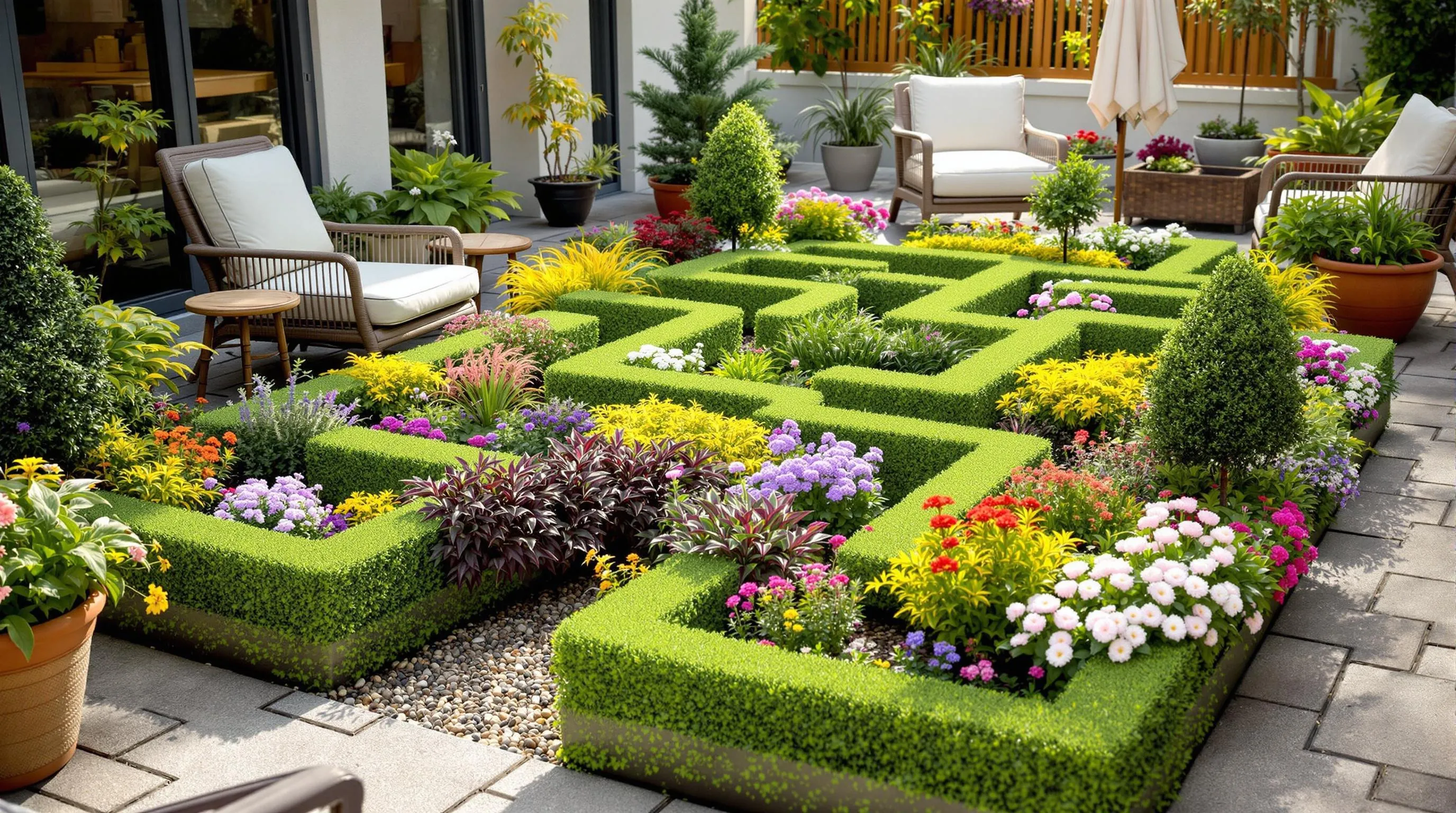
Don’t let a small garden space deter you from creating your own botanical maze. Miniature mazes can deliver the same enchantment as their larger counterparts while fitting into compact urban gardens, patios, or balconies.
Container and Raised Bed Maze Designs
Transform your limited outdoor area into a captivating miniature maze using containers and raised beds. Start with a central plan using multiple planters arranged in a pattern that creates narrow pathways—square or circular containers work particularly well for defining corners and intersections. Choose dwarf hedge varieties like boxwood ‘Suffruticosa’ or Japanese holly ‘Helleri’ that maintain their compact form without extensive pruning. For added vertical interest, incorporate raised beds of varying heights (12-24 inches) to create multi-level pathways that maximize your limited footprint. These elevated designs not only make your maze more accessible for maintenance but also create a more immersive experience as visitors navigate through the compact yet intricate layout. Consider adding miniature focal points like tiny benches, fairy garden elements, or small water features at key junctions to reward exploration through your pocket-sized labyrinth.
Tabletop and Patio Mazes
Create charming tabletop mazes using shallow trays or repurposed furniture pieces to bring the maze experience to any surface. Begin with a low-profile container at least 3 inches deep and fill it with quality potting mix suitable for small plants. Design your miniature maze using diminutive varieties like dwarf thyme, baby tears (Soleirolia soleirolii), or Irish moss (Sagina subulata) that naturally grow to just 1-2 inches tall. Mark pathways using fine gravel, colored sand, or miniature pebbles that contrast with the green plantings. For more definition, incorporate tiny figurines, miniature garden stakes, or hand-painted stones as directional markers or points of interest. These portable designs can be seasonally refreshed and relocated to follow optimal light conditions, making them perfect for apartments or homes with changing outdoor access. Enhance the interactive appeal by creating themed mazes that change with holidays or seasons—using miniature pumpkins in fall or tiny pinecones for winter displays.
Vertical Wall Mazes
Maximize your garden space by going vertical with wall-mounted maze designs that transform ordinary surfaces into living puzzles. Install a sturdy trellis system or repurpose pallets against a fence or wall, creating a grid pattern with at least 12 x 12 inch openings. Plant climbing vines like miniature ivies, creeping fig, or wire vine at strategic points to grow along designated paths, training them with garden twine or small hooks. For instant impact, incorporate small wall-mounted containers or pocket planters that can hold compact growers like sedums, mini ferns, or trailing lobelia. Design your vertical maze with clear entry and exit points, using contrasting plant textures and colors to define the correct route. These living wall mazes not only conserve valuable floor space but also provide natural cooling, sound absorption, and a striking visual focal point for small gardens or courtyards. For year-round interest, integrate small solar-powered fairy lights or weather-resistant art elements that guide visitors through the vertical journey.
Children’s Adventure Mazes with Interactive Elements
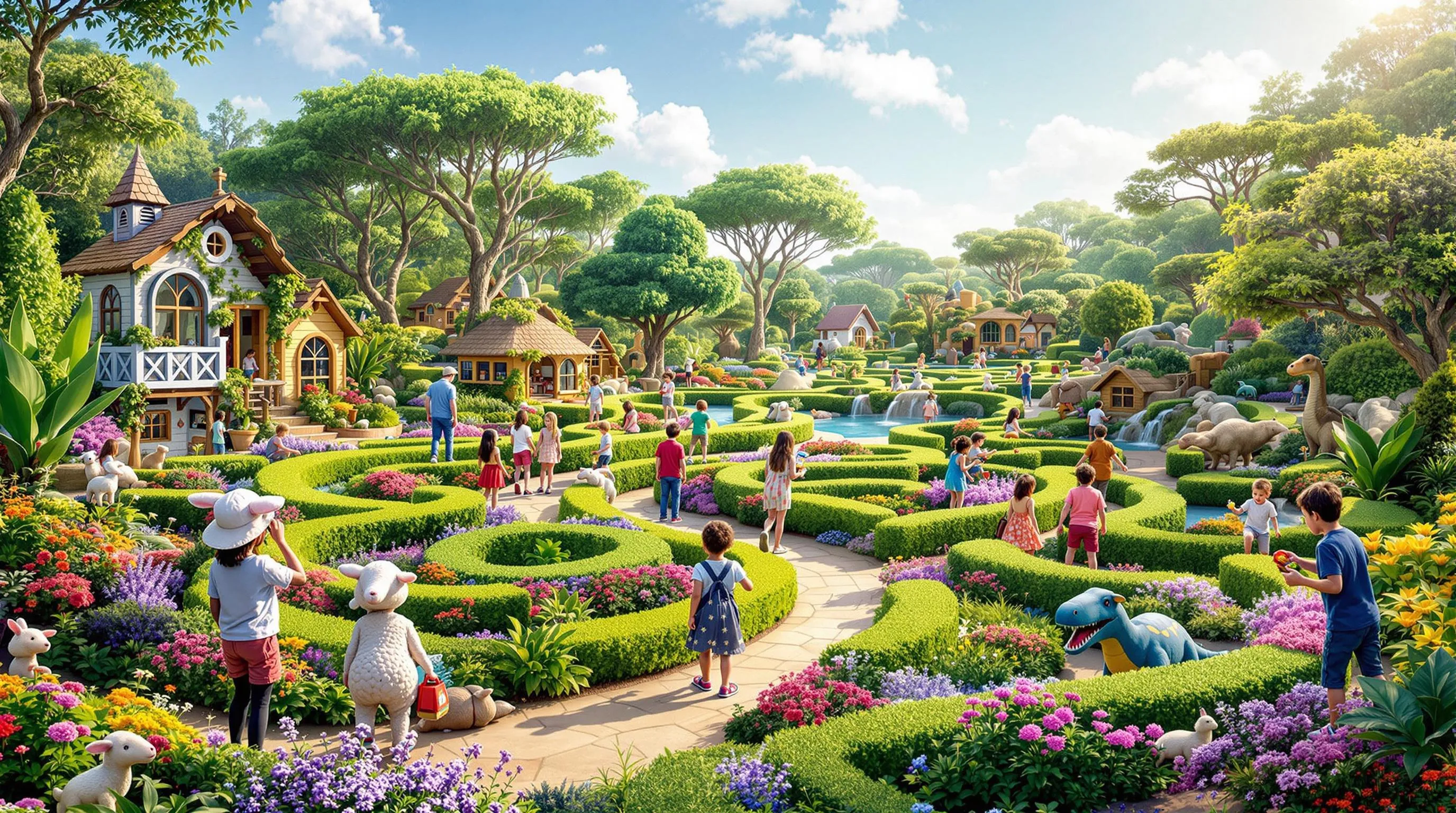
Transform your botanical maze into a magical wonderland where children can explore, learn, and play through interactive elements that stimulate their imagination and curiosity.
Educational Plant Selection for Kids’ Discovery
Create an captivating learning environment by selecting plants that naturally attract children’s attention and teach them about nature. Incorporate lamb’s ears (Stachys byzantina) for their irresistibly soft, touchable leaves that introduce texture concepts. Plant chocolate cosmos or pineapple sage for their surprising scents that demonstrate how plants can smell like familiar foods. Include sensitive plants (Mimosa pudica) that react to touch by folding their leaves, showcasing plant responses to stimuli. Designate “discovery stations” throughout the maze with informative yet playful signage about each plant’s unique characteristics and origin. Choose colorful varieties like rainbow chard, purple basil, and multicolored snapdragons to demonstrate nature’s diverse palette. For maximum educational impact, group plants by scientific classifications or native regions, creating distinct “continents” within your maze that represent different worldwide ecosystems.
Interactive Elements That Encourage Exploration
Elevate your children’s maze with hands-on activities that transform it from a simple path into an immersive adventure. Install weather-resistant puzzles at key junctions that, when solved, reveal clues about which direction to take next. Create sensory stations with different textured materials like smooth stones, rough bark, and soft moss that children can touch while blindfolded to guess what they’re feeling. Incorporate musical elements by hanging wind chimes or installing durable outdoor xylophones that respond to touch or movement. Design simple water features with hand pumps or water wheels that demonstrate basic physics principles while providing refreshing play opportunities. Include hidden wildlife habitats like bug hotels or butterfly gardens that encourage children to observe native species. For tech-savvy families, consider QR codes on weatherproof plaques that link to educational videos or augmented reality experiences about the surrounding plants and network.
Themed Adventure Paths and Storytelling Elements
Design your children’s maze with captivating themes that transform navigation into an exciting adventure. Create a dinosaur discovery path with prehistoric plant species like ferns and cycads alongside child-safe resin fossils hidden throughout the route. Develop a fairy tale journey featuring miniature cottages, bridges, and whimsical sculptures that bring beloved stories to life among appropriate plantings. Install weatherproof storyboards at key points that unfold a progressive narrative as children advance through the maze. Incorporate role-playing elements with designated activity stations where kids can become explorers, scientists, or magical creatures completing special “missions.” Use pathway materials to reinforce themes—smooth river stones for water adventures or glittering paths for enchanted forest experiences. For seasonal interest, design paths that change their theme throughout the year, from spring pollinator hunts to autumn harvest celebrations, encouraging repeat visits and new discoveries.
Edible Mazes: Combining Beauty with Functionality
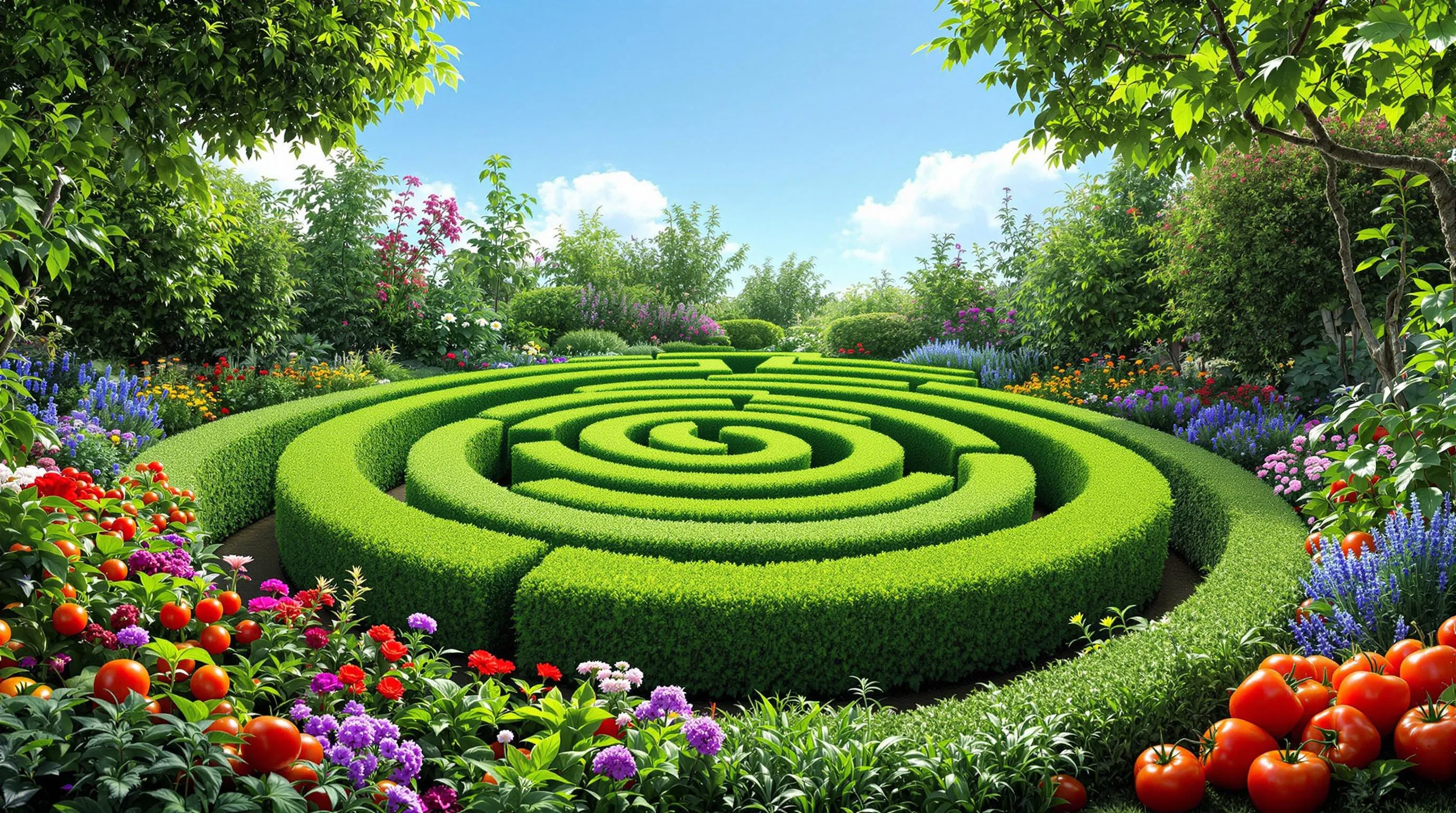
Edible mazes transform traditional garden labyrinths into productive spaces that nourish both body and soul. These functional designs merge the puzzle-like appeal of mazes with the practicality of food production, creating interactive landscapes that visitors can literally harvest as they explore.
Herb Spirals and Vegetable Labyrinths
Herb spirals offer a compact, three-dimensional maze experience that maximizes growing space while creating a visually stunning focal point. Design your spiral with lower-growing herbs like thyme and oregano at the bottom edges, working up to taller varieties like rosemary and sage at the center. The spiral shape naturally creates different microclimates, with sunnier, drier conditions at the top and shadier, moister areas at the bottom. For larger spaces, vegetable labyrinths transform traditional row gardening into winding pathways bordered by seasonal crops. Try creating paths lined with tomato trellises, pepper plants, and climbing beans that form living walls as they grow. Structure your edible maze with permanent elements like dwarf fruit trees or berry bushes as anchor points, then fill in seasonal beds with rotating crops to maintain visual interest and soil health year-round. These productive puzzles not only provide fresh food but also serve as educational tools that demonstrate sustainable growing practices while captivating visitors in the journey from garden to table.
Japanese-Inspired Zen Mazes for Meditation
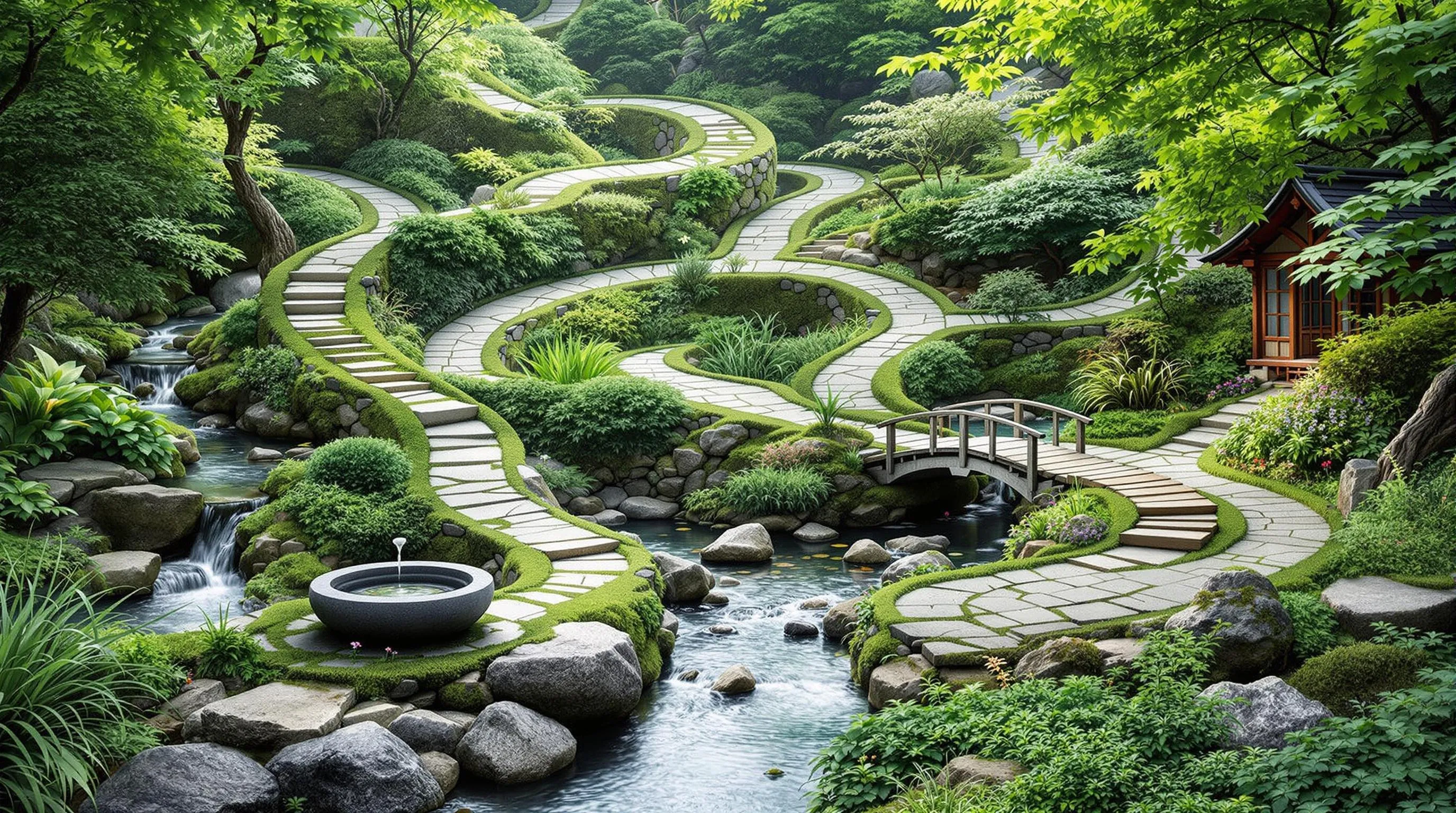
Japanese-inspired zen mazes offer a perfect blend of mindfulness and artistic garden design. Unlike traditional hedge mazes focused on challenge, these serene pathways prioritize contemplation and spiritual connection, creating spaces that calm the mind while captivating the senses.
Incorporating Water Features and Stone Elements
Water features serve as vital components in Japanese zen mazes, symbolizing purity and the flow of life. You’ll find tranquility by integrating a small meandering stream alongside your maze path or placing a stone basin fountain at key meditation points. Strategically position weathered stones and boulders to represent mountains and islands, creating “dry industry” sections reminiscent of traditional karesansui gardens. These natural elements establish visual anchor points that guide meditation while encouraging mindful observation. Combine smooth river rocks with moss-covered stones for textural contrast, and consider installing a small wooden bridge over water features to represent the journey from the material to spiritual industry. These thoughtful additions transform a simple garden maze into a multisensory meditation experience that honors authentic Japanese design principles while promoting mental clarity and inner peace.
Illuminated Night Mazes: Lighting Design Ideas
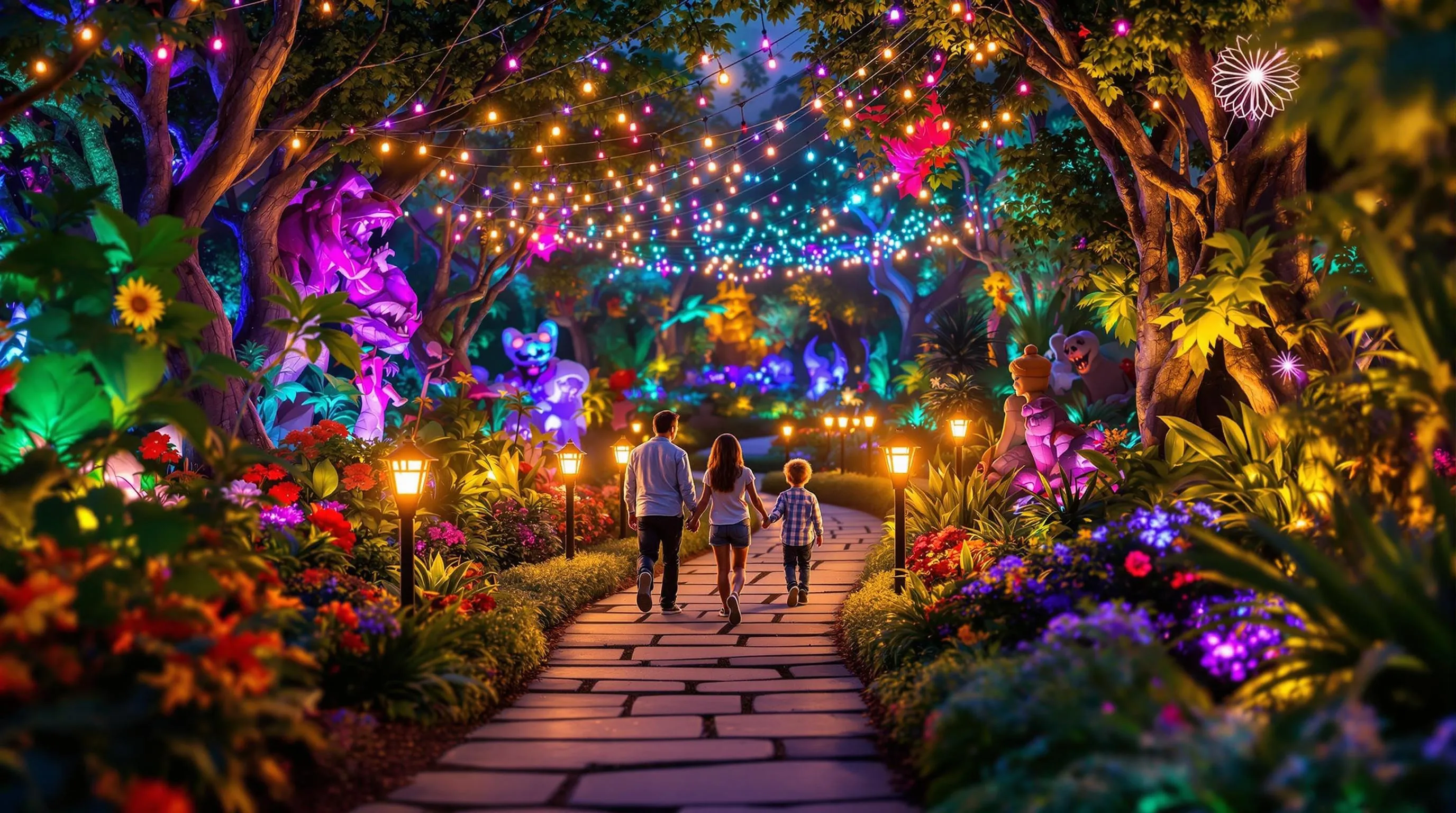
Transform your botanical maze into a mesmerizing nighttime destination with strategic illumination that creates an entirely new experience after sunset. Lighting design adds drama, safety, and extended hours of enjoyment to your living labyrinth.
Solar and Low-Voltage Options for Evening Exploration
Solar pathway lights offer an eco-friendly solution for illuminating your maze without complex wiring. Position these self-charging fixtures along main routes to create gentle guidance through the pathways while minimizing light pollution. For more reliable brightness, consider low-voltage LED systems that provide consistent illumination while consuming minimal electricity. These systems can be installed with timers or smart controllers to activate at dusk automatically. Bollard lights work exceptionally well for marking decision points within your maze, while subtle ground-level lighting can accentuate the contours of hedges without overwhelming the natural nighttime ambiance. For smaller mazes, solar-powered string lights draped through overhead structures create a magical canopy effect that transforms the space into an enchanted garden experience.
Highlighting Focal Points and Features
Strategic accent lighting draws attention to your maze’s most impressive elements while creating navigation landmarks. Uplight specimen plants or sculptures with well-placed spotlights to create dramatic shadows and silhouettes against the night sky. Submersible LED lights transform water features into glowing focal points, with color-changing options allowing seasonal theme adaptations. Illuminate archways and entrances with gentle wash lighting to signal transitions between maze sections and provide subtle wayfinding cues. Consider installing programmable RGB lights near remarkable plantings to highlight seasonal blooms with complementary colors that enhance their natural beauty. These thoughtfully positioned feature lights not only improve navigation but also create Instagram-worthy vignettes throughout your nighttime maze journey.
Creating Atmosphere with Color and Shadow
The strategic use of colored lighting transforms your maze from merely visible to truly magical after dark. Cool blue and purple tones create a mysterious, moonlit atmosphere perfect for adult-oriented evening events. For family-friendly experiences, incorporate playful amber and warm white lights that provide sufficient visibility while maintaining a welcoming ambiance. Position lights at varying heights to cast intriguing shadows that add depth and dimension to flat hedge walls. Consider thematic lighting schemes that change with seasons—orange and purple for autumn events or cool white and blue for winter celebrations. Motion-activated color-changing fixtures add an interactive element, responding to visitors’ movements with subtle shifts in hue that create a sense of the maze responding to its explorers.
Interactive Lighting Elements and Technology
Elevate your night maze experience with interactive lighting that responds to visitor movements or scheduled programming. Motion sensors can trigger sequential lighting that illuminates the path ahead while dimming behind, creating a living corridor that follows explorers through the maze. Install weather-resistant speakers alongside synchronized lights for immersive sound and light shows that transform your maze into an outdoor theater experience. Programmable RGB flood lights allow for scheduled color changes throughout the evening, creating ever-changing experiences that evolve as night progresses. For special events, consider portable projection systems that cast moving patterns or seasonal imagery onto hedge walls, transforming them into living screens. These technological elements add a layer of engagement that encourages evening visits and creates memorable experiences that distinguish your maze from daytime-only attractions.
Sustainable Maze Design: Eco-Friendly Materials and Methods
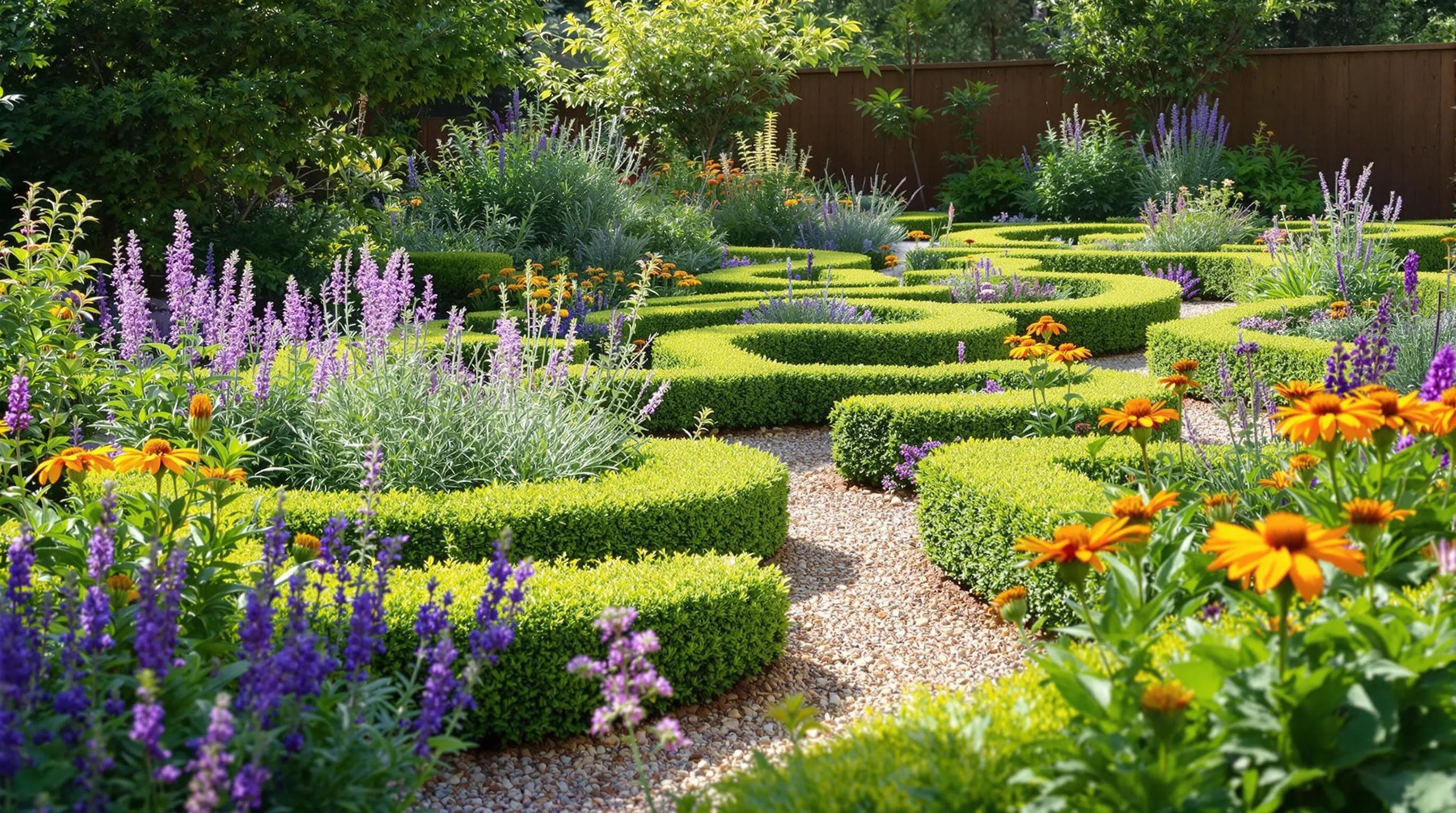
Creating botanical mazes doesn’t have to come at the expense of the environment. Sustainable maze design focuses on eco-friendly materials and methods that reduce environmental impact while creating beautiful, captivating spaces.
Drought-Resistant Plants for Low-Maintenance Mazes
Drought-resistant plants offer the perfect solution for creating sustainable mazes that thrive with minimal water requirements. Native species like lavender, rosemary, and yarrow establish deep root systems that require infrequent watering once established. You’ll save up to 60% on water consumption by selecting Mediterranean herbs and ornamental grasses that naturally withstand dry conditions. Plants like Russian sage, sedum, and ornamental miscanthus create striking maze walls while demonstrating remarkable resilience during dry spells. For path borders, consider using recycled materials like crushed stone or mulch from fallen trees to complement your water-wise plantings. Incorporating these drought-tolerant varieties not only reduces resource consumption but also creates a low-maintenance maze that remains visually appealing throughout changing weather patterns.
Rainwater Harvesting Systems
Carry out strategic rainwater collection systems to maintain your maze sustainably. Rain barrels positioned at downspouts can capture up to 55 gallons during a single rainfall, providing irrigation during dry periods. For larger mazes, consider installing underground cisterns that store hundreds of gallons beneath pathway intersections. Connect these systems to drip irrigation lines that deliver water directly to plant roots, reducing waste by up to 70% compared to conventional sprinklers. You’ll maximize efficiency by programming timers to release water during early morning hours when evaporation rates are lowest. These harvesting systems not only conserve precious water resources but also protect plants from stress during seasonal rainfall fluctuations, ensuring your maze maintains its structural integrity and visual appeal year-round.
Composting and Natural Fertilizers
Transform maze maintenance clippings into valuable resources through on-site composting stations. Establish dedicated composting areas near maze entrances where hedge trimmings, fallen leaves, and other organic materials can decompose into nutrient-rich soil amendments. You’ll create a closed-loop system by applying finished compost to maze plantings, improving soil structure and reducing the need for chemical fertilizers by up to 80%. For additional natural fertilization, consider planting nitrogen-fixing companion plants like clover in strategic locations throughout your maze. These plants naturally enrich surrounding soil while supporting beneficial insects. Many sustainable maze designers also incorporate compost tea applications—brewing concentrated liquid fertilizer from compost in 55-gallon drums and applying it monthly during growing seasons to strengthen plant immunity and vigor naturally.
Biodegradable Construction Materials
Replace conventional construction elements with biodegradable alternatives that break down naturally over time. Woven willow fencing creates temporary maze walls that decompose after 3-5 years, returning nutrients to the soil while providing structure until permanent plantings mature. For pathway edging, explore compressed bamboo borders or hemp-based composite materials that resist rot for 5-7 years before harmlessly biodegrading. You’ll enhance sustainability by using coconut coir mats for erosion control on sloped sections, providing up to 24 months of stability while allowing plants to establish. For maze features like benches and signage, consider mushroom-based materials or reclaimed wood treated with beeswax rather than chemical preservatives. These natural materials not only reduce environmental impact but also add rustic aesthetic appeal that complements the organic nature of botanical mazes.
Pollinator-Friendly Design Elements
Integrate pollinator support into your maze design by including flowering plants that attract beneficial insects. Designate 15-20% of your maze plantings for pollinator favorites like echinacea, salvia, and native wildflowers that provide nectar throughout growing seasons. You’ll create biodiversity hotspots by installing mason bee houses and butterfly puddling stations at key intersections, transforming your maze into valuable habitat. For structural elements, incorporate hollow logs or drilled wooden posts that serve as insect hotels while functioning as directional markers. These dual-purpose features support declining pollinator populations while improving the educational value of your maze. Many sustainable maze designers also establish unmowed refuge areas adjacent to maze boundaries, allowing native grasses and wildflowers to support local pollinators and beneficial insects that help control pests naturally.
Conclusion: Bringing Your Botanical Maze Vision to Life
Your botanical maze can be more than just pathways through plants—it’s a living canvas for creativity and connection with nature. Whether you choose a classic boxwood design a sensory lavender labyrinth or a child-friendly adventure maze your creation will evolve and delight through every season.
Remember that even small spaces can accommodate miniature mazes while larger landscapes offer room for elaborate designs with illuminated pathways or sustainable features. The beauty of botanical mazes lies in their versatility and personal expression.
Start planning your maze today considering your climate available space and maintenance preferences. Soon you’ll have created not just a garden feature but an immersive experience that engages visitors through sight scent and exploration—a truly living work of art.







